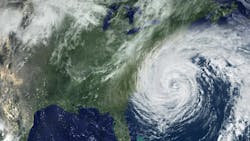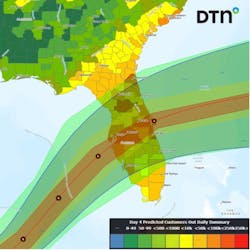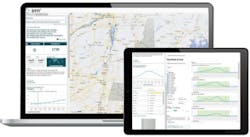Forecasting Power Outages in Advance of Hurricanes and Severe Storms
For utility operators, the greatest challenge during severe weather events isn’t just responding to outages – it’s anticipating them accurately to secure and position resources most effectively. The evolution of this predictive capability, from educated guesswork to data-driven forecasting, represents one of our industry’s most significant operational advances.
Due to a lack of confidence in their forecasting capabilities, utilities often hesitated to mobilize outside contractors early enough to pre-stage for severe weather events, resulting in slower response times and delayed restoration efforts." For example, when Hurricane Irma struck Florida in 2017, it caused unprecedented power outages across the state, with one-third of the state’s utility customers losing power at one point during the storm. The widespread nature of these outages was a wake-up call for the critical importance of better preparedness and response planning.
Moreover, utilities often did not know in advance exactly how many people they might need to dispatch to restore power. Based on their experience, utility companies could estimate pretty well, but often not perfectly.
That ability has grown even better with the addition of AI and machine learning, leading us to Hurricane Ian in 2022 and Milton earlier this year as good examples of how the ability to forecast power outages has improved over the years.
On September 26, nearly two days before Hurricane Ian made landfall, our team here at DTN predicted that 4.59 million customers would experience outages during the storm.
Hurricane Ian’s predicted track fluctuated by hundreds of miles as it developed, making it challenging for businesses, emergency crews, service providers, and residents to prepare. Two days later, it finally landed in southern Florida as a Category Four hurricane. After briefly moving offshore in northeastern Florida and downgrading to a tropical storm, Hurricane Ian quickly regained power and made a second landfall in South Carolina. It fully dissipated in North Carolina by the month’s end.
The forecast was within 7% of the actual outage count of 4.29 million customers. However, as the hurricane intensity and track evolved, new real-time information was integrated into models, and updated predictions were delivered every six hours. The revised forecast, made one day before landfall, estimated 4.42 million customers out, within 3% of the actual outages.
It was no different when Hurricane Milton struck the Tampa Bay area earlier this year. The hope is to make informed decisions before the storm makes landfall and minimize the power outages as much as possible.
And while Hurricane Milton left a path of destruction behind it, the data was there to predict the number of outages with incredible accuracy. The accuracy of this real-time data allowed Florida utilities to prepare for the storm and restore power faster, proving the importance of having data-driven solutions for hurricanes. This helped businesses and homeowners return to their normal lives in days instead of weeks or months.
Before Hurricane Milton hit, our hurricane forecasting team predicted that 3.3 million people would be without power following the hurricane. We ended up getting a razor-close prediction, with the real number coming in at 3.2 million.
The technology works by combining data from many different sources. It integrates data from utility infrastructure, customers’ meters, wind speeds, nearby power lines, and weather forecasts to make the prediction. It also combines seven years of verified historical outage and weather data with advanced weather and machine learning models that can be tailored to a utility’s operating region and topography. We can now more accurately predict weather impacts on a service area up to seven days ahead of an expected weather event.
Of course, this comes during a time of increased climate volatility. Decisions are always difficult when the weather batters the power grid, and utility companies are under pressure from customers who want their power restored quickly and politicians, regulators, and even the media.
That’s why it pays to understand your risks, prepare for changing weather conditions, and create plans that can be activated at a moment’s notice. While utility companies cannot control the weather, they can control their response and plan accordingly.
Before Hurricane Milton, utility companies could prepare for how many outages there would be and have crews ready after the damage had been done. Crews were deployed in high-risk areas before the storm hit, and resources were positioned strategically to reduce damage. Because of this, communities were able to get their power restored much faster, getting them back to a normal life as soon as possible.
Accurately predicting storms such as Hurricanes Ian and Milton shows what’s possible when data meets new innovations. And, as weather and outage models improve, people can expect to see even greater accuracy and efficacy in weather and storm predictions, which would help more communities prepare for future hurricanes and other severe storms with more confidence.
About the Author
Renny Vandewege
Renny Vandewege ([email protected]) is Vice President of Weather Operations at DTN, where he is responsible for developing strategic direction for weather business serving the aviation, energy, offshore, shipping, transportation, and sports & safety markets, as well as providing leadership to 200+ operational meteorologists across weather forecast rooms globally. Prior to joining the private weather industry, Renny served as the director of the Broadcast Meteorology Program at Mississippi State University, advising and training over 200 broadcast meteorologists in his time teaching in the program. He began his career in meteorology as a broadcast meteorologist at WTOK in Meridian, MS and KCTV in Kansas City, MO, most notably covering historic Hurricane Katrina as it made landfall in Mississippi. Renny holds a master’s degree from Mississippi State University.


